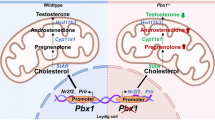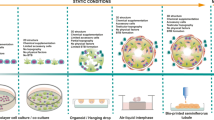Abstract
In an attempt to elucidate the mechanism of sterility of X-autosome translocations in the mouse, we studied the distribution of [3H]-uridine incorporation in sterile males carrying the balanced X-16 reciprocal translocation. The results failed to show an overall reactivation of the X as has been postulated by Lifschytz and Lindsley (1972) but there was some spreading of X inactivation along the translocated and normal chromosome 16 in those regions that were close to the X breakpoint. We feel that this process could be responsible for metabolic disturbances leading to degeneration of primary spermatocytes and, therefore, to sterility.
Similar content being viewed by others
References
Batanian J, Hulten MA (1987) Electron microscopic investigations of synaptonemal complexes in an infertile human male carrier of a pericentric inversion inv(1) (p32, q42). Regular loops formation but defective synapsis including a possible interchromosomal effect. Hum Genet 76:81–86
Boer P de, Branje HEB (1979) Association of the extra chromosome of tertiary trisomic male mice with the sex chromosomes during first meiotic prophase, and its significance for impairment of spermatogenesis. Chromosoma 73:369–379
Chandley AC, Speed RM, McBeath S, Hargreave TB (1986) A human 9; 20 reciprocal translocation associated with male infertility analyzed at prophase and metaphase I of meiosis. Cytogenet Cell Genet 41:145–153
Fletcher JM (1979) Light microscope analysis of meiotic prophase chromosomes by silver staining. Chromosoma 72:241–248
Forejt J (1974) Non-random association between a specific autosome and the X-chromosome in meiosis of the male mouse: possible consequence of homologous centromeres separation. Cytogenet Cell Genet 13:369–383
Forejt J (1979) Meiotic studies of translocations causing male sterility in the mouse. II. Double heterozygous for Robertsonian translocations. Cytogenet Cell Genet 23:163–170
Forejt J, Gregorova S (1977) Meiotic studies of translocation causing male sterility in the mouse. I. Autosomal reciprocal translocations. Cytogenet Cell Genet 19:159–179
Forejt J, Gregorova S, Goetz P (1981) XY pair associated with the synaptonemal complex of autosomal male-sterile translocations in pachytene spermatocytes of the mouse (Mus musculus). Chromosoma 82:41–53
Gabriel-Robez O, Ratomponirina C, Dutrillaux B, Carré-Pigeon F, Rumpler Y (1986) Meiotic association between the XY chromosomes and the autosomal quadrivalent of a reciprocal translocation in two infertile men 46,XY t(1–9;22) and 46,XY (17;21). Cytogenet Cell Genet 43:154–160
Hotta Y, Chandley AC (1982) Activities of X-linked enzymes in spermatocytes of mice rendered sterile by chromosomal alteration. Gamete Res 6:65–72
Johannisson R, Löhrs U, Wolff HH, Schwinger E (1987) Two different XY-quadrivalent associations and impairment of fertility in men. Cytogenet Cell Genet 45:222–230
Kierzenbaum AL, Tres LL (1974) Nucleolar and perichromosomal RNA synthesis during meiotic prophase in the mouse testis. J Cell Biol 60:39–53
Lifschytz E, Lindsley DL (1972) The role of X-chromosome inactivation during spermatogenesis. Proc Natl Acad Sci USA 69:182–186
Loir M (1972) Métabolisme de l'acide ribonucléique et des protéines dans les spermatocytes et les spermatides du bélier (Ovis aries). Ann Biol Anim Bioch Biophys 12(2): 203–219
Luciani JM, Guichaoua MR, Mattei MA, Morazzani MR (1984) Pachytene analysis of a man with a 13q;14q translocation and infertility. Behaviour of the trivalent and non-random association with the sex vesicle. Cytogenet Cell Genet 38:14–22
Lyon MF, Searle AG, Ford CE, Ohno S (1964) A mouse translocation suppressing sex linked-variegation. Cytogenetics 3:306–323
Miklos GLG (1974) Sex-chromosome pairing and male fertility. Cytogenet Cell Genet 13:558–577
Monesi V (1965) Synthetic activities during spermatogenesis in the mouse. Exp Cell Res 39:197–224
Ratomponirina C, Couturier J, Gabriel-Robez O, Rumpler Y, Dutrillaux B, Croquette M, Rabache Q, Leduc M (1985) Aberrations of the synaptonemal complexes in a male 46,XY, −14, +der(14)t(Y;14). Ann Génet (Paris) 28(4):214–218
Rosenmann A, Wahrman J, Richler C, Voss R, Persitz A, Goldman B (1985) Meiotic association between the XY chromosomes and unpaired autosomal elements as a cause of human male sterility. Cytogenet Cell Genet 39:19–29
Saadallah N, Hulten MA (1985) A complex three breakpoint translocation involving chromosomes 2,4 and 9 identified by meiotic investigations of a human male ascertained for subfertility. Hum Genet 71:312–320
Searle AG (1962) Is sex-linked tabby really recessive in the mouse? (Abstract) Heredity 17:297
Söderström KO (1976) Characterization of RNA synthesis in midpachytene spermatocytes of the rat. Exp Cell Res 102:237–245
Speed RM (1986) Abnormal RNA synthesis in sex vesicles of tertiary trisomic male mice. Chromosoma 93:267–270
Takagi N (1980) Primary and secondary non-random X chromosome inactivation in early female mouse embryos carrying Searle's translocation T(X;16) 16H. Chromosoma 81:439–459
Tres LL (1975) Nucleolar RNA synthesis of meiotic prophase spermatocytes in the human testis. Chromosoma 53:141–151
Utakoji T (1966) Chronology of nucleic acid synthesis in meiosis of the male Chinese hamster. Exp Cell Res 42:585–596
Viguié F, Romani F, Dadoune JR (1982) Male sterility in a case of (Y;6) balanced reciprocal translocation. Mitotic and meiotic study. Hum Genet 62:225–227
Author information
Authors and Affiliations
Rights and permissions
About this article
Cite this article
Jaafar, H., Gabriel-Robez, O. & Rumpler, Y. Pattern of ribonucleic acid synthesis in vitro in primary spermatocytes from mouse testis carrying an X-autosome translocation. Chromosoma 98, 330–334 (1989). https://doi.org/10.1007/BF00292385
Received:
Issue Date:
DOI: https://doi.org/10.1007/BF00292385




